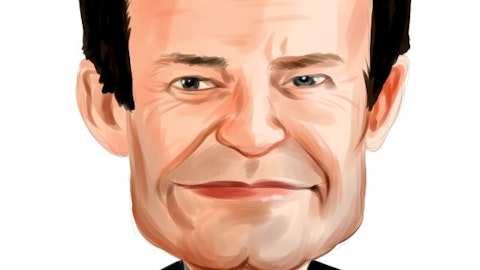Scott Ullem: And Larry, it’s Scott. For the second part of your question about FX. We’ll talk about more of the specifics at the investor conference. But if you take our exchange rate environment right now and apply it to 2024, it would be a headwind to sales, and also a headwind to EPS. So we’ll be able to quantify that more specifically. And we’ll see what happens to FX rates between now and then as well.
Larry Biegelsen: Thank you, guys.
Operator: Our next question comes from Vijay Kumar with Evercore ISI. Please state your question.
Vijay Kumar: Hey guys. Thanks for taking my question. Bernard, maybe a first one for you on this TAVR five year data that was presented. A lot of noise in the Street on the lines crossing for Edwards and your peer, the lines widening between TAVR and Control. Does that worry you at all just from Edwards’ perspective when you look at the data. And I think you also mentioned [indiscernible] definition for durability. Is that something that your peer also use the same definition or are there some differences here and how durability was defined in these two trials?
Bernard Zovighian: Thank you, Vijay. Let me start high level, I believe last night, investor event was, very insightful with Dr. Leon and Dr. Mark. They went very deep into the data. They went very deep into the meaning, the meaning of the data and the trial design. At the end of the day, you know, for me, it is I like to keep it very simple. 90% survival at five years. That’s amazing for patients that’s in my mind, what we should remember, but I’m going to ask Larry to comment and with a greater detail here.
Larry Wood: Yeah. Thanks, Bernard. Yeah. This whole thing about the curves continuing to diverge, just isn’t really accurate. I think we had a little bit of a catch up. But if you notice from the New England Journal Medicine manuscript, we are impacted somewhat by the patients that withdrew on the surgical side disproportionately. And when we did the phone sweep, the absolute difference that we’re showing at five years is about 1%. When you go into the causes of death, you look at cardiovascular mortality, they’re about the same. We had, I think, double the rate of cancer. We had 3 times as much COVID death in the TAVR group, as we had in the surgical group. And I think higher rates of sepsis, which were all adjudicated to be not TAVR related.
And I don’t think anybody is suggesting that TAVR causes cancer or COVID. So when you get into the depths of the data, I mean, we feel great about the data. What’s amazing about this data set is that both groups performed incredibly well. And given the prominence of Edwards surgical valves, and then obviously our TAVR cohort, we’re looking at both groups that have over 90% survival at five years. And the other thing that people have been worried about with TAVR was durability. And you’re right, we did use the bark definitions for durability, which remember, isn’t what — with surgery is historically used. Surgery historically is used, freedom from X plant due to structural valve deterioration, not echo derived criteria. And so, part of what drives the New England Journal of Medicine publication is we used all the contemporary standards, all the contemporary things.
So, I don’t want to comment on other people’s data. You can ask them about their data and what methodologies they use. But I’m very comfortable we applied the highest academic standard STAAR study. And again, we feel great about the data. And I think there’s just a little bit of an oddity here that, that people are discussing that somehow TAVR has to be better than the surgery. If we have two procedures, TAVR and surgery, and we can go to patients and say, your results are identical at five years. Then that’s going to automatically default people to the less invasive therapy. And now, we need to continue to follow these patients. We need to follow them all the way up to 10 years. But for a pretty significant interim look at the data at five years, I don’t think we could be any happier about the data than we are.
Bernard Zovighian: And in addition, Vijay, if you think about what we have been seeing all along about the underdiagnosis and undertreatment of this patient. Now you look at this PARTNER 3 five years, we hope — we certainly hope, that we’re referring network of cardiologists will send more patients because they have options, safe options, effective options. So we feel good about all of this
Larry Wood: Yeah. I mean, I’ll just add. I think this was a great day. Great meeting for the field in general. If you have patients on the sidelines, who say I’m just — I just don’t want to have open heart surgery, I’m too scared of open heart surgery. But they’re being told, TAVR doesn’t really have any data behind it and it’s still early. If you look at both datasets that were presented, there is absolutely no durability signal at five years or four years, depending on which study you’re looking at. And I think that’s to just give the referral community tremendous confidence that they can patients for this procedure and they’re going to get a durable outcome.
Vijay Kumar: That’s helpful guys. And Bernard, just one more for you. There were some headlines on investigation in Europe. Any financial implications here, it’s just the headlines looked a little, little odd. And I know it’s a silly question but I have to ask. Is there any GLP-1 exposure to TAVR or TAVR patients related to based in GLP-1s. Thank you.
Bernard Zovighian: No, thanks. In Europe, no, there is, no financial exposure. We had a brief statement on that. So no expectation here. With regards to GLP-1 exposure to TAVR, we don’t think so. We have not seen any evidence that, losing weight has any impact to aortic stenosis disease. We don’t, we don’t know that, we don’t see that. We don’t — we have not seen any evidence. So we don’t see any, any possible implication here. Larry, anything to add?
Larry Wood: No, I totally agree. I think, as it relates to just general things, obviously people losing weight is a good thing, but we’ve never seen anything related to even, even coronary disease, but a lot of these things are genetically derived and genetically driven, and I don’t think your weight is going to be the determinant of those things. So I don’t really see any impact of this.
Vijay Kumar: Understood. Thanks, guys.
Operator: Our next question comes from Josh Jennings with TD Cowen. Please state your question.
Joshua Jennings: Hi. Good afternoon. Thanks for taking the questions. I wanted to just ask first on the tricuspid repair and replacement segment, and just get your views on patient reported outcomes, driving approvals and then potentially reimbursement decisions, positive reimbursement decisions. Are patient reported outcomes or quality of life improvements enough to clear the, those two hurdles?




